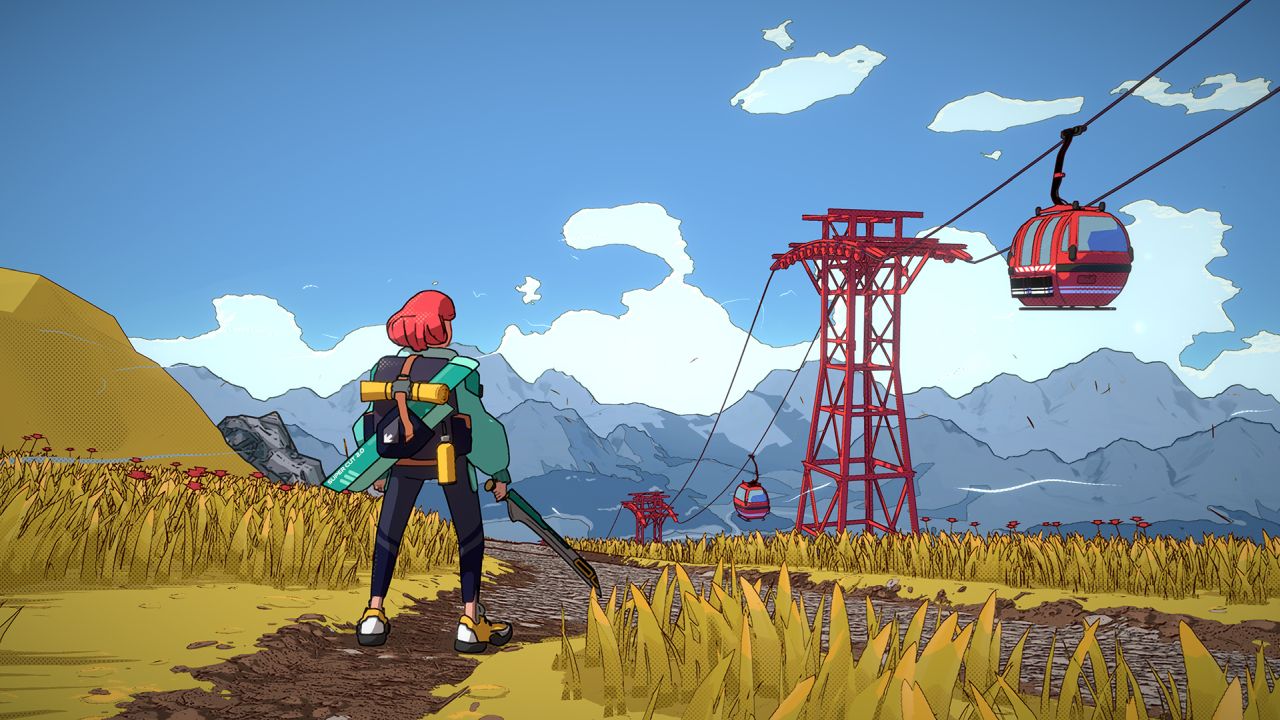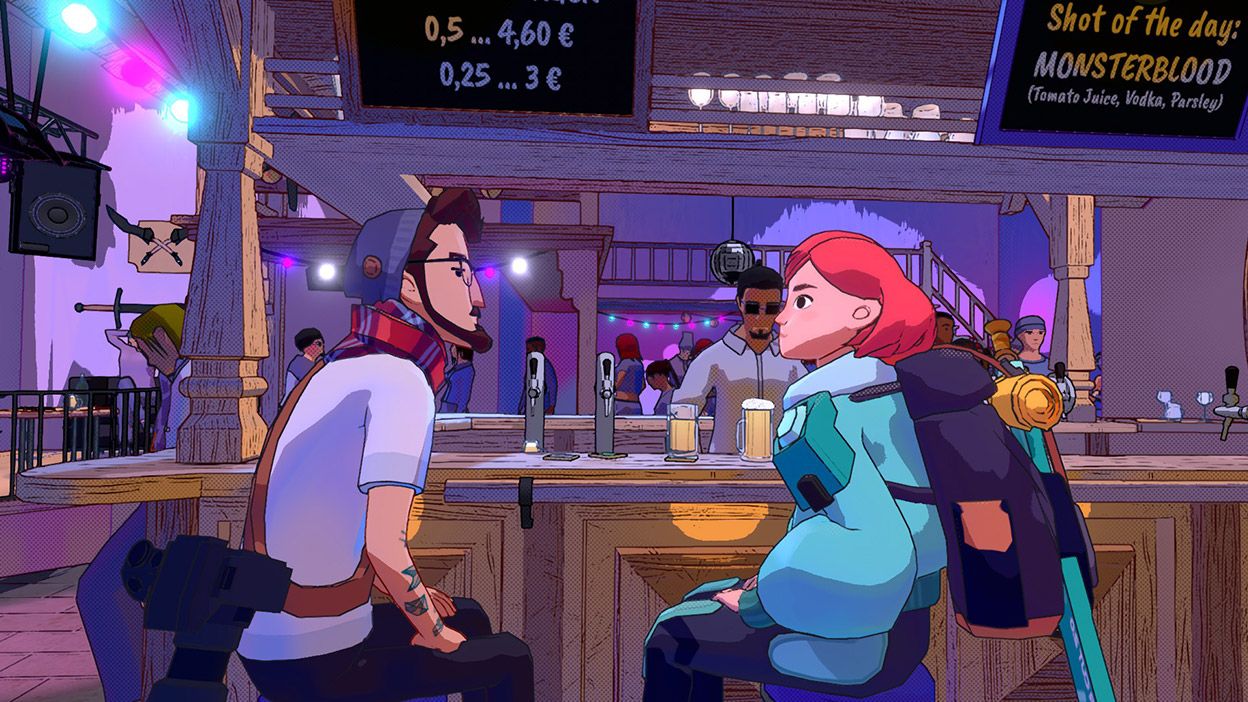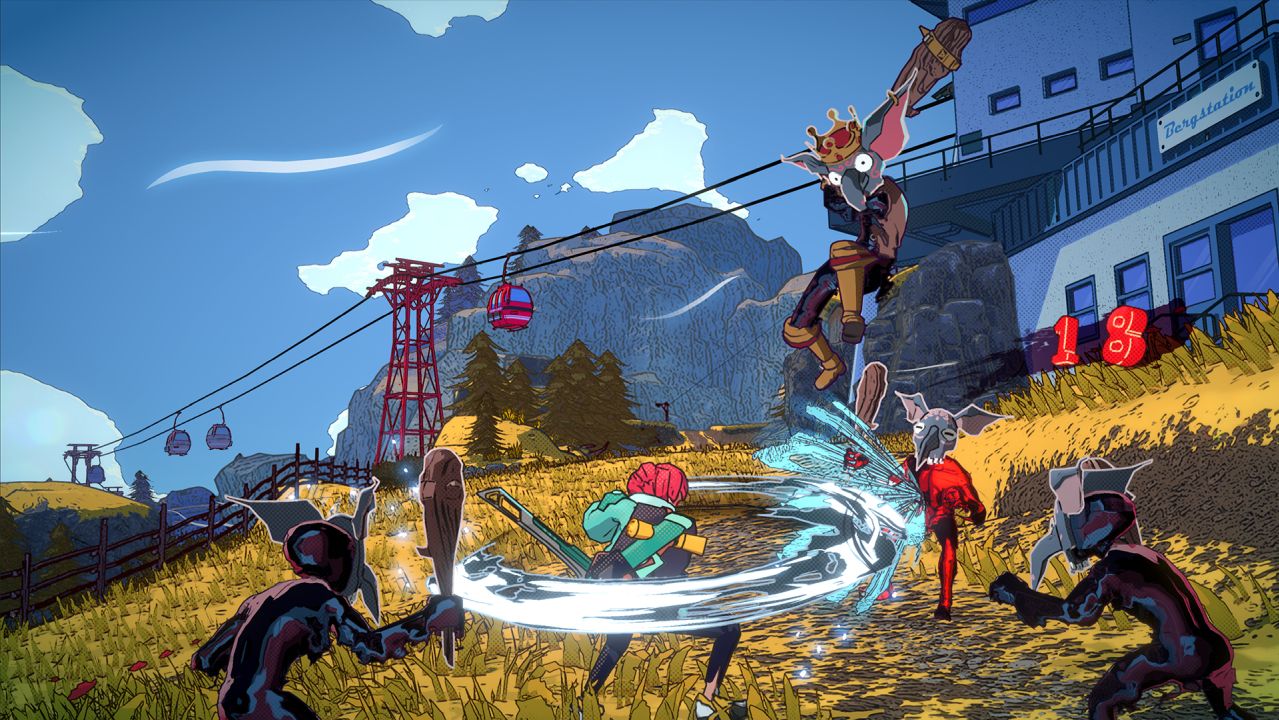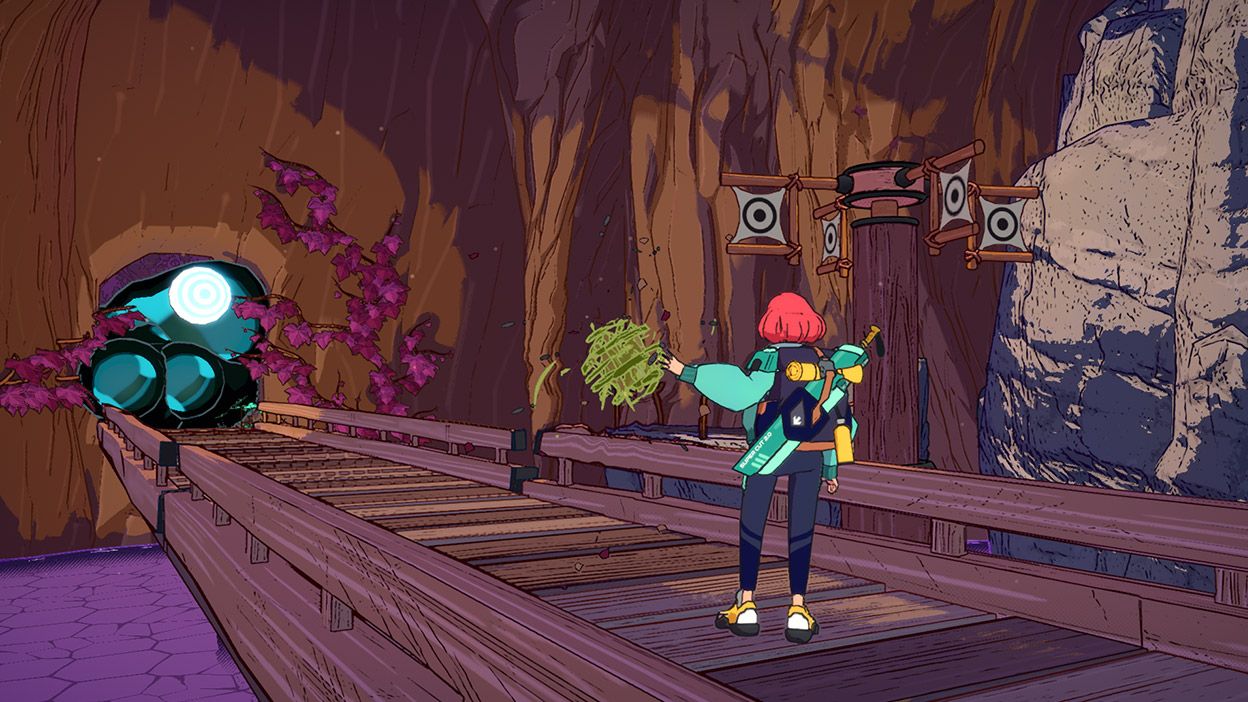Dungeons of Hinterberg Review
As I write this, it’s currently a sweltering, mid-90’s day in New Jersey. Global warming may make fools of us all eventually, but the high temp means that it’s summer. As someone who burns easily, I’m not one for hot vacations this time of year. I’m more comfortable spending time in cooler conditions for my time out of office. And if I had the funds, I’d be pretty interested in traveling to Hinterberg. The weather looks great, and the vibes are immaculate. Alas, that’s not in the cards, so I can only get to experience that trip via Dungeons of Hinterberg, a new single player third person action game. Of course, in this version of the Austrian village, magic is flowing through the streets.

Looking to take a break from her job as a lawyer, Luisa has come to Hinterberg on vacation in search of something new. The small village has become quite the tourist spot due to the presence of magic and dungeons. Slayers have come from all over the world to take down the beasts hiding within these dungeons. While Luisa is still a novice when it comes to this profession, she soon shows a strong knack for it. As she works her way through the 25 dungeons of Hinterberg, she begins to realize that all is not what it seems in this idyllic village. Luisa will need to work with both tourists and residents of the town to uncover the secrets buried within.
Coming into Dungeons of Hinterberg, I wasn’t sure what to expect from the story. I figured it would be a tale of a busy city dweller learning to unwind through the power of monsters and small-town charm. And in some ways, it is kind of that. After a rough first day, Luisa goes from caustic newbie to seasoned pro due to the help of the colorful locals. I loved spending time with the cast, and the game gives you plenty of time to explore these relationships. My top hangs were with cynical teens Thea & David that grew up in Hinterberg, and Renaud, the pro slayer whose appearance takes after Blade. However, there’s a deeper story at play here as well. One about gentrification and whether the presence of magic has been a blessing or curse for the town. The story goes in interesting directions I wasn’t expecting but was glad to see develop.
There’s a basic loop to each day you spend in Hinterberg. It is segmented into three different portions: Afternoon, Evening & Night. Afternoon is when you will be out exploring one of the regions and their dungeons. You don’t have to enter a dungeon, though, as you can choose to spend time exploring the region without entering a portal. When you return in the evening, you’ll be able to spend time in Hinterberg proper. Activities include hitting up the local shops or spending time with one of your new friends. And at night, you can either choose to get a good night’s rest or stay up and raise some of your stats. It may remind players of the Persona series’ time management structure – but quite barebones.
There are four different attributes that can be raised throughout your vacation. Renown, Amusement, Familiarity and Relaxation. Each of them is pretty self-explanatory. Renown tracks your level of popularity among other slayers and the general public. Amusement covers spending time with friends or watching local programing, while relaxation also includes hanging out with others. It also includes spending your afternoon at one of several scenic spots found in each smaller region of the village. Familiarity measures how much knowledge you have about Hinterberg proper. Older citizens can help bolster your knowledge, or you can read literature left in your hotel room. Specific characters can only be talked to if one of these stats have been raised to a certain level. In turn, if you are not able to interact with these characters, you will not be able to reach all the dungeons. There are plenty of ways to raise these stats, though, and the game does a good job of letting you know when you could do so. Like any good vacation, there’s no need to stress about it.

Most of your time in Dungeons of Hinterberg will be spent exploring the titular dungeons. The 25 dungeons are spread across four biomes, and this also includes individual boss dungeons found in each one. Besides their unique climates, what also separates them from each other is that you have different magic skills that can only be used in their respective region. There are two skills that come with each infusion of magic, with both being usable for traversal and combat. For example, one region lets you spawn a jelly cube that can be climbed upon, and shoot a ball of electricity that can damage enemies and trigger switches.
By limiting the magic to specific regions, Microbird Games has been able to craft dungeons that constantly feel unique from the last. The developer does a great job of mixing things up and making sure that you won’t get bored during your time with the game. This is done through using your magical abilities in differing ways, or in just how the dungeons themselves are laid out. One level may be exclusively played with a top-down perspective as you sail down a poisonous river, while another has you grinding across rails as if it were an on-rails shooter. Much like Luisa, I constantly found myself looking forward to jumping into the next dungeon available. Your magic abilities are also used to good effect in the game’s puzzles. There’s nothing too taxing here, but they do a good job of integrating your abilities into different situations. One region has you conjuring mini tornadoes in ways that can move you and specific objects for example, and that leads to some cleverly designed situations.
With that said, I do think the fun level design helps cover for the more simplistic combat. What you have here is a routine hack and slasher, with only a few bursts of additional variety included. Luisa has light and heavy strikes, as well as her magic abilities. Your skills can be augmented with charms, attack conduits and gear enhancements. Charms are trinkets that provide boosts to skills such as physical damage or give you new abilities such as slowing down enemy attacks if you hit a perfect dodge. Attack conduits are special maneuvers that deal greater or specialized damage. One of my favorites was Ravenous Hunger, which automatically destroys enemy magic shields. Gear enhancements are purchasable upgrades for both your sword and pieces of armor. They could offer better protection or boosts to damage based on upon your current stats.
There’s nothing terrible about the combat, but it also doesn’t feel like it ever really evolves. Once you lock into a charm and attack conduit set you like, there’s nothing forcing you to switch things up. The enemy variety doesn’t provide a stiff enough challenge for necessary modification to be a thing. I played through the game on normal, and I never felt in danger during my time with the campaign. To be fair, I don’t think the game is too enamored with giving players trouble. That doesn’t mean the combat should be as static as it is, though. There’s room for shaking things up while also keeping the overall difficulty at a manageable level.

After spending your afternoon in one of the sub-regions, you can return to Hinterberg proper for evening activities, with a handful of shops to visit. You can stock up on potions or grab gifts to give to your town friends. I’m not sure if there is a way to determine what gift is best suited for what person, but giving a good one will result in improvements to your relationship with them and potentially an item in return. Local gear shops also provide opportunities to improve your attack and defense levels. There’s no traditional leveling system in the game, with stats being raised based around the gear you have. Strong gear can be acquired through chests found in dungeons, maximizing certain friendships or through the shops. I wouldn’t say I was overpowered by end of game, but I felt more than comfortable handling the advanced dungeons.
Dungeons of Hinterberg places a strong emphasis on building relationships with other slayers and locals of the area. Unless a story specific event is taking place, you have the chance to hang out with one character per evening. There’s not a ton of depth to these interactions, as you are mostly just picking responses to their prompts. You could either support whatever they are babbling about or push back on it. I don’t think choosing either or will negatively affect the relationships, as I can’t imagine there being multiple endings for each character story. Typically, once you reach a certain level with a character, they will approach you in the afternoon for an activity. This can take place in lieu of you tackling a regular dungeon. While it may drag out your time with the game, I do recommend working on fully completing these relationships. Some of the gear you get is top level, and I had charms and conduits received as part of my end-game build as well. I wish the game had done a better job of making it so there were as many afternoon activities as there were evening ones. I ran out of dungeons to complete before I had maxed out all my relationships. In turn, this led to me quickly exiting sub-regions in the afternoon just to get to the evening.
While the visuals of Dungeons of Hinterberg are lacking technical polish, I do love the vibes they evoke. Hinterberg has the look and feel of a charming little village, from the quaint buildings to the scenic views. The individual regions have solid looks to them as well. I loved the swampy style of Brunnelsumpf and the rustic Hinterwald specifically. The character designs are good as well, and while there isn’t a ton of facial animation to them, they do a good job of depicting emotions. All of this is coated in a colorful, cel shaded style that fits the charms of the game. There’s no spoken dialogue in the game, so animating mouth movements wasn’t a priority here.

However, there is perhaps a lack of technical polish to the visuals. I noticed pieces of Luisa clipping through objects during cut-scenes, and there is pop-in throughout. Some of that is most likely a design choice, but it does look a little weird to see NPCs pop in and out of a scene. With no spoken dialogue, and a middling soundtrack, this turned into a bit of a podcast game for me. I would have liked to see some more variety with the enemies. The goblins you are slaying are bland, and even the more advanced enemies don’t stand out much from the lesser grunts.
Dungeons of Hinterberg provided the right amount of chill action to make beating the heat this summer enjoyable. The vibes are great, and the gameplay has enough variety to keep you locked in across the 25 dungeons. While I can’t see myself returning for a repeat run, the 20 hours length didn’t overstay its welcome either. I loved seeing what gameplay mechanic was going to be the focus of each new dungeon I entered. While the personality is strong, the fundamentals of the game are lacking at times. The hack and slash combat doesn’t evolve much, and the relationship building segments could have used more variety. The visuals were also technically shaky across both Steam Deck and PC. There’s enough creativity and heart here, though, to overcome these deficiencies.
